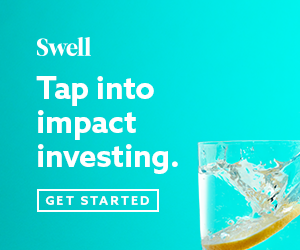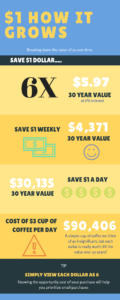Let’s try to breakdown a common goal into something that is more relevant and achievable.
This is probably one of the more common goals that people may say. Of course, we all have ambitions to make more money, live more freely, or buy more things. However, caution should be taken if this is one of your main goals.
Why it is not a good goal:
- It lacks any real time-line and therefore does not give you urgency.
- It does not have any defined path to let you know you are making progress.
- What are the boundaries? $100K, $1M, $10M, $100M. What exactly is “Rich” or “a lot of money”
- It can not be broken down into manageable pieces.
So how can we create a goal that defines “Rich”? Well, think about the things that are important and why you want to be rich. Is it material things like a big house, expensive travel, or nice cars. Is it the lifestyle? Is it security? You have to understand what it is that you want. You may discover that you don’t need to be rich to get what it is you are after.
Let’s say you live in the city and you want to become rich so that you can live by the beach. Simply having a goal to live by the beach is far better than the generic goal of “I want to be rich”. It still is not very good though. Let’s try to break it down a bit more.
Look for Positive Motivation Statements
Why do you want to live by the beach? Is it to surf to stay healthy, meet new people, enjoy sunsets? Find two or three things that define why that should be a goal. Let’s choose to surf and meet new people.
Define a timeline
We have to put a time constraint on our goals so that we can further break them down into manageable and achievable components. Be realistic, if you can’t put a timeline around the goal then it is too broad or not well defined. For our example lets use 5-years.
Make it achievable (with some work)
Fact is unless you have substantial wealth already built you are not going to be able to buy the $20M beach mansion on the water. That would be a silly goal and would set you up to fail. A more realistic choice would be a small fixer as close as you can get but without getting too expensive. Remember, in our goal the reason why we want to be at the beach is to surf and meet new people. The size and type of property should not be important.
To continue this example, we see that a small fixer house biking distance to the beach is $525K or you could rent something for $2,500.
Now put it all together
Goal: “I want to improve my health and social life by being closer to the beach where I can surf daily, meet like-minded friends, and improve my life. To save for costs, I will save money, find new sources of revenue over the next five years to either buy or rent an entry-level beach house. “
Action Plan: This is where you test and breakdown the goal to see if it is possible.
- How much money is needed in 5 years- $20K per year to save $100K for a down payment.
- How much income is needed-Mortgage payment/Rent: $2,500-3,000 per month.
- A new job might be required
So whether you can achieve this depends on your situation and how close or how far you are from these primary factors. If you have a job where you get a yearly bonus of $15K that you normally just spend, you actually very close and only need to find an extra $5K per year.
Can you afford the rent or mortgage? Again it matters how far are you from being able to afford the cost based on what you would be paying now? If for example, you only need an extra $500 per month, then there are lots of passive income ideas that can make that after 6-12 months of putting in some dedication. Making that second source of revenue has now become a child goal and you would break it down just like we did for the larger one.
After you have really thought about your situation and broken down your goals the final strategy might be something like this:
| Year 1 | Year 2 | Year 3 | Year 4 | Year 5 | Goal | |
| Down Payment 100K | $20,000 | $20,000 | $20,000 | $20,000 | $20,000 | $100,000 |
| -Save bonus | $15,000 | $15,000 | $15,000 | $15,000 | $15,000 | $75,000 |
| -Buy fewer things | $1,000 | $1,000 | $1,000 | $1,500 | $2,000 | $6,500 |
| -Find Alternate Revenue | $500 | $1,000 | $2,000 | $4,000 | $6,000 | $13,500 |
| -Save any pay increases | $1,000 | $1,000 | $1,000 | $1,000 | $1,000 | $5,000 |
For each of the items, you could break them down into short and long term goals that help you reach them. For example, maybe daily coffee is your vice at $5 a cup. Make a short term goal to eliminate coffee or make it at home. If you succeed, you can continue to find more ways to save or earn money.
in Summary
If you have large lofty goals, they have to be broken down into small achievable pieces that get you closer to the final goal. It is not always easy, but when you do I think you will find that some of the things that you really want are actually much closer than you think.
Here is a video from Gillian Perkins about setting goals!
Good Luck! Please post any successes you have had in the comments below for others to be inspired.







I really like how clear your writing is. This was a really helpful little article.
The biggest financial goal that I’ve hit recently has been to get rid of my credit card debt. It was 5 times my monthly income, and I was paying through the nose for it.
As you said, having a timeline and defining the steps I needed to take really helped me get it under control